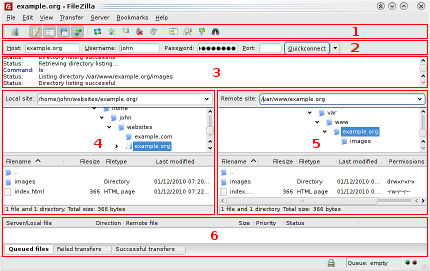FileZilla Client Tutorial (en): Difference between revisions
m (Reverted edits by 221.214.27.253 (Talk) to last revision by 66.194.214.130) |
|||
| Line 43: | Line 43: | ||
Here is a quick introduction: Below the ''toolbar'' (1) and ''quickconnect bar'' (2), the ''message log'' (3) displays transfer and connection related messages. Below, you can find the file listings. The left column (''local pane'', 4) displays the local files and directories, i.e. the stuff on the PC you're using FileZilla on. The right column (''server pane'', 5) displays the files and directories on the server you are connected to. Both columns have a directory tree at the top and a detailed listing of the currently selected directory's contents at the bottom. You can easily navigate either of the trees and lists by clicking around like in any other file manager. At the bottom of the window, the ''transfer queue'' (6) lists the to-be-transferred and already transferred files. | Here is a quick introduction: Below the ''toolbar'' (1) and ''quickconnect bar'' (2), the ''message log'' (3) displays transfer and connection related messages. Below, you can find the file listings. The left column (''local pane'', 4) displays the local files and directories, i.e. the stuff on the PC you're using FileZilla on. The right column (''server pane'', 5) displays the files and directories on the server you are connected to. Both columns have a directory tree at the top and a detailed listing of the currently selected directory's contents at the bottom. You can easily navigate either of the trees and lists by clicking around like in any other file manager. At the bottom of the window, the ''transfer queue'' (6) lists the to-be-transferred and already transferred files. | ||
Youve got it in one. Coludnt have put it better. | |||
== Using the site manager == | == Using the site manager == | ||
Revision as of 07:02, 16 May 2011
This tutorial in other languages: English (English), Deutsch (German)
Note to editors: Please read this note on the tutorial scope before making additions.
Introduction
Welcome to the FileZilla Client tutorial. In this tutorial, you will learn how to
- connect to an FTP server,
- download and upload files,
- use the site manager.
If you already know how to use an FTP client, you may want to read the more advanced usage instructions instead.
We assume that you already installed and started FileZilla Client (installation instructions).
Connecting to a server
The first thing to do is connecting to a server.
This is our (fictional) login data - please use your own data instead if you want to actively follow the tutorial.
Hostname: example.org Username: john Password: 7PjU#.J3
We will use the quickconnect bar for establishing the connection:
Enter the hostname into the quickconnect bar's Host: field, the username into the Username: field as well as the password into the Password: field. You may leave the Port: field empty unless your login information specifies a certain port to use. Now click on Quickconnect.
Note: If your login information specifies a protocol like SFTP or FTPS, enter the hostname as follows: sftp://hostname or ftps://hostname respectively.
FileZilla will now try to connect to the server. If all works well, you will notice that the right "column" switched from Not connected to any server to displaying a list of files and directories.

The next step is to get familiar with FileZilla's window layout.
Here is a quick introduction: Below the toolbar (1) and quickconnect bar (2), the message log (3) displays transfer and connection related messages. Below, you can find the file listings. The left column (local pane, 4) displays the local files and directories, i.e. the stuff on the PC you're using FileZilla on. The right column (server pane, 5) displays the files and directories on the server you are connected to. Both columns have a directory tree at the top and a detailed listing of the currently selected directory's contents at the bottom. You can easily navigate either of the trees and lists by clicking around like in any other file manager. At the bottom of the window, the transfer queue (6) lists the to-be-transferred and already transferred files.
Youve got it in one. Coludnt have put it better.
Using the site manager
Now that you are confident in transferring files (if not, practice a little bit), you might want to add the server information to the site manager to make it easy to reconnect to this server. To do this, select Copy current connection to Site Manager... in the File menu. The site manager will be opened and a new entry will be created with all the important information already filled in. You will notice that the entry's name is selected and highlighted - you can enter some descriptive name so you will later on find your server again (enter something like domain.com FTP server for example - you can rename it later if you wish). Now close the dialog by clicking on OK.
The next time you want to connect to this server, you can simply select it in the site manager and click Connect.
Conclusion
You should now be able to use the basic FileZilla features.
One final remark: Most tasks can be completed in several ways. The ways chosen for this tutorial are the most clear ones - if you invest a bit of time and just look around or read some of the advanced documentation, you will find much quicker ways to achieve what you want (there are toolbar buttons for often-used commands for example; some also react on right-clicking them).
If you feel reasonably confident by now, it might be worthwhile to also read the advanced usage instructions to learn about additional features not shown in this tutorial.
Further information
- Documentation: Documentation for the most important topics
- Site manager: Details about how to set up your sites in FileZilla